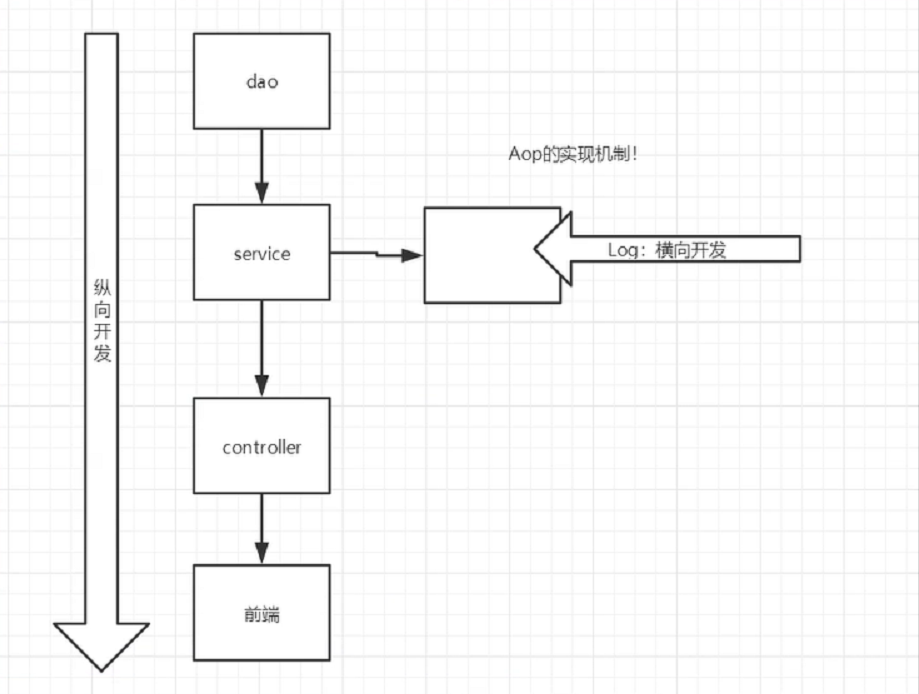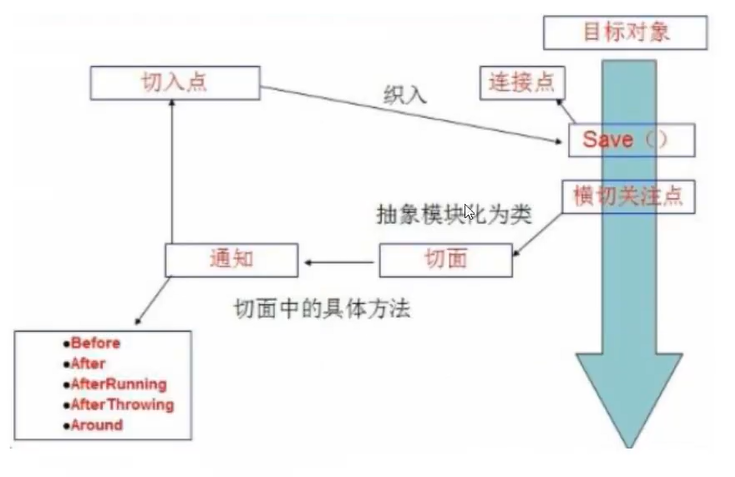1.Spring
1.简介
Spring : 春天 --->给软件行业带来了春天
2002年,Rod Jahnson首次推出了Spring框架雏形interface21框架。
2004年3月24日,Spring框架以interface21框架为基础,经过重新设计,发布了1.0正式版。
很难想象Rod Johnson的学历 , 他是悉尼大学的博士,然而他的专业不是计算机,而是音乐学。
Spring理念 : 使现有技术更加实用 . 本身就是一个大杂烩 , 整合现有的框架技术
官网 : http://spring.io/
官方下载地址 : https://repo.spring.io/libs-release-local/org/springframework/spring/
GitHub : https://github.com/spring-projects
2.优点
1、Spring是一个开源免费的框架 , 容器 .
2、Spring是一个轻量级的框架 , 非侵入式的 .
3、控制反转 IoC , 面向切面 Aop
4、对事物的支持 , 对框架的支持
.......
一句话概括:
Spring是一个轻量级的控制反转(IoC)和面向切面(AOP)的容器(框架)。
3.组成

Spring 框架是一个分层架构,由 7 个定义良好的模块组成。Spring 模块构建在核心容器之上,核心容器定义了创建、配置和管理 bean 的方式 .

组成 Spring 框架的每个模块(或组件)都可以单独存在,或者与其他一个或多个模块联合实现。每个模块的功能如下:
- 核心容器:核心容器提供 Spring 框架的基本功能。核心容器的主要组件是 BeanFactory,它是工厂模式的实现。BeanFactory 使用控制反转(IOC) 模式将应用程序的配置和依赖性规范与实际的应用程序代码分开。
- Spring 上下文:Spring 上下文是一个配置文件,向 Spring 框架提供上下文信息。Spring 上下文包括企业服务,例如 JNDI、EJB、电子邮件、国际化、校验和调度功能。
- Spring AOP:通过配置管理特性,Spring AOP 模块直接将面向切面的编程功能 , 集成到了 Spring 框架中。所以,可以很容易地使 Spring 框架管理任何支持 AOP的对象。Spring AOP 模块为基于 Spring 的应用程序中的对象提供了事务管理服务。通过使用 Spring AOP,不用依赖组件,就可以将声明性事务管理集成到应用程序中。
- Spring DAO:JDBC DAO 抽象层提供了有意义的异常层次结构,可用该结构来管理异常处理和不同数据库供应商抛出的错误消息。异常层次结构简化了错误处理,并且极大地降低了需要编写的异常代码数量(例如打开和关闭连接)。Spring DAO 的面向 JDBC 的异常遵从通用的 DAO 异常层次结构。
- Spring ORM:Spring 框架插入了若干个 ORM 框架,从而提供了 ORM 的对象关系工具,其中包括 JDO、Hibernate 和 iBatis SQL Map。所有这些都遵从 Spring 的通用事务和 DAO 异常层次结构。
- Spring Web 模块:Web 上下文模块建立在应用程序上下文模块之上,为基于 Web 的应用程序提供了上下文。所以,Spring 框架支持与 Jakarta Struts 的集成。Web 模块还简化了处理多部分请求以及将请求参数绑定到域对象的工作。
- Spring MVC 框架:MVC 框架是一个全功能的构建 Web 应用程序的 MVC 实现。通过策略接口,MVC 框架变成为高度可配置的,MVC 容纳了大量视图技术,其中包括 JSP、Velocity、Tiles、iText 和 POI。
4.拓展
Spring Boot与Spring Cloud
- Spring Boot 是 Spring 的一套快速配置脚手架,可以基于Spring Boot 快速开发单个微服务;
- Spring Cloud是基于Spring Boot实现的;
- Spring Boot专注于快速、方便集成的单个微服务个体,Spring Cloud关注全局的服务治理框架;
- Spring Boot使用了约束优于配置的理念,很多集成方案已经帮你选择好了,能不配置就不配置 , Spring Cloud很大的一部分是基于Spring Boot来实现,Spring Boot可以离开Spring Cloud独立使用开发项目,但是Spring Cloud离不开Spring Boot,属于依赖的关系。
- SpringBoot在SpringClound中起到了承上启下的作用,如果你要学习SpringCloud必须要学习SpringBoot。
2.Spring—IOC
1.在Maven项目中添加Spring依赖
<dependencies>
<!-- https://mvnrepository.com/artifact/org.springframework/spring-webmvc -->
<dependency>
<groupId>org.springframework</groupId>
<artifactId>spring-webmvc</artifactId>
<version>5.3.9</version>
</dependency>
</dependencies>
2.IOC的本质
控制反转IoC(Inversion of Control),是一种设计思想,DI(依赖注入)是实现IOC的一种方法,在没有IoC的程序中,我们使用面向对象的编程,对象的创建与对象间的依赖关系完全硬编码在程序中,对象的创建由程序自己控制,控制反转将对象的创建转移给第三方,个人认为所谓控制反转就是:获得依赖对象的方式反转了。
采用XML方式配置Bean的时候,Bean的定义信息是和实现分离的,而采用注解的方式可以把两者合为一体,Bean的定义信息直接以注解的形式定义在实现类中,从而达到了零配置的目的。
控制反转是通过描述(XML或注解)并通过第三方去生产或获取特定对象的方式。在Spring中实现控制反转的是IoC容器,其实现方法是依赖注入(Dependency Injection,DI)。
3.配置Spring的元数据
<?xml version="1.0" encoding="UTF-8"?>
<beans xmlns="http://www.springframework.org/schema/beans"
xmlns:xsi="http://www.w3.org/2001/XMLSchema-instance"
xsi:schemaLocation="http://www.springframework.org/schema/beans
https://www.springframework.org/schema/beans/spring-beans.xsd">
<bean id="hello" class="com.dzj.pojo.Hello">
<property name="name" value="dengzhijiang"></property>
</bean>
<!-- more bean definitions go here -->
</beans>
4.获取Spring的上下文对象
读取容器
ApplicationContext context = new ClassPathXmlApplicationContext("benas.xml");
5.Spring创建对象
<bean id="userService" class="com.dzj.service.impl.UserServiceImpl">
<!--
ref:引用Spring容器中已经创建好的对象
value:基本的值,基本数据类型
-->
<property name="userDao" ref="oracle"></property>
</bean>
6.不同数据类型的注入方式
private String name;
private Address address;
private String[] books;
private List<String> hobbies;
private Map<String,String> card;
private Set<String> games;
private String wife;
<bean id="address" class="com.dzj.pojo.Address">
<property name="address" value="湛江市"></property>
</bean>
<bean id="student" class="com.dzj.pojo.Student">
<!--第一种,普通值注入,value-->
<property name="name" value="邓志江" />
<!--第二种,bean注入,ref-->
<property name="address" ref="address"/>
<!--数组-->
<property name="books">
<array>
<value>红楼梦</value>
<value>西游记</value>
<value>水浒传</value>
<value>三国演义</value>
</array>
</property>
<!--List-->
<property name="hobbies">
<list>
<value>听歌</value>
<value>写字</value>
<value>运动</value>
</list>
</property>
<!--map-->
<property name="card">
<map>
<entry key="省份证" value="44088219981211"></entry>
<entry key="银行卡" value="201824113212"></entry>
</map>
</property>
<!--set-->
<property name="games">
<set>
<value>LOL</value>
<value>COC</value>
<value>BOB</value>
</set>
</property>
<!--null-->
<property name="wife">
<null/>
</property>
<!--properties-->
<property name="info">
<props>
<prop key="driver">20182411</prop>
<prop key="gender">男</prop>
<prop key="username">小明</prop>
<prop key="password">123456</prop>
</props>
</property>
</bean>
7.扩展方式注入
c命名空间和p命名空间的注入:不能直接使用,需要导入xml约束
xmlns:p="http://www.springframework.org/schema/p"
xmlns:c="http://www.springframework.org/schema/c"
<!--p命名空间注入,可以直接注入属性的值,property-->
<bean id="user" class="com.dzj.pojo.User" p:name="邓志江" p:age="22"></bean>
<!--c命名空间注入,通过构造器注入,construct-args-->
<bean id="user2" class="com.dzj.pojo.User" c:name="林勇" c:age="22" ></bean>
8.bean的作用域
1、单例模式(Spring默认模式)
<bean id="user" class="com.dzj.pojo.User" p:name="邓志江" p:age="22" scope="singleton"></bean>
2、原型模式(每次从容器中get的时候,都会产生一个新的对象!
<bean id="user2" class="com.dzj.pojo.User" c:name="林勇" c:age="22" scope="prototype"></bean>
3、其余的 @request、@sesstion、@application 这些只能在web开发中使用到!
9.bean的自动装配
- autowired:byName ---> 必须保证所有的 bean 的 id 的唯一,并且这个 bean 需要和自动注入的属性的 set 方法的值一致。
- autowired:byType ---> 必须保证所有的 bean 的 class 的唯一,并且这个 bean 需要和自动注入的属性的类型一致!
private String name;
@Autowired
private Cat cat;
@Autowired
private Dog dog;
<!--自动装配需要加上-->
<context:annotation-config/>
<bean id="cat" class="com.dzj.pojo.Cat"></bean>
<bean id="dog" class="com.dzj.pojo.Dog"></bean>
<!--
byName: 会自动在容器的上下文中查找,和自己对象set方法后面值对应的 beanid!
byType: 会自动在容器的上下文中查找,和自己对象属性类型相同的 bean!
-->
<bean id="person" class="com.dzj.pojo.Person" autowire="byName">
<property name="name" value="小公羊"/>
<!--<property name="cat" ref="cat"/>-->
<!--<property name="dog" ref="dog"/>-->
</bean>
注解说明
-@autowired:自动装配通过类型、名字
如果@autowired没有自动装配上属性,则需要通过@qualifier(value = “ ”)
-@nullable 如果字段标记了这个注解,说明这个字段可以为null
-@resource:自动装配通过类型、名字
将类注册到容器中
-@component :组件,放在这个类上,说明这个类被Spring管理了,就是bean!
等价于:
-@Value: 给属性赋值,等价于:
<!--需要在 xml 中开启注解扫描,才能检测到注册bean的类-->
<context:component-scan base-package="com.dzj.dao"/>
@component组件的衍生:在web开发中,会按照三层架构分层
dao【@Repository】
service【@Service】
controller【@Controller】
这四个注解功能都是一样的,都是将我们的类注册到Spring容器
10.在纯java类中配置的方法
第一种方法:
1、在实体类的头部添加注解--@component
@Value注解用来给对象的属性赋值
@Component
public class User {
@Value("zhijiang")
public String name;
public void show(){
System.out.println("成功了...");
}
}
2、在配置类 MyConfig 中添加两个注解
--@configuration ---> 代替 beans.xml 文件,相当于这个类就是一个spring容器
--@componentScan --> 用来扫描实体类,哪些类注册了 bean
@Configuration
@ComponentScan("com.dzj.pojo")
public class MyConfig {
}
3、获取容器中的对象
ApplicationContext context = new AnnotationConfigApplicationContext(MyConfig.class);
User user = context.getBean("user", User.class);
第二种方法:
1、无需在实体类中添加多余的注解,若想给对象的属性赋值,只需用@Value注解给属性赋值即可
public class User {
@Value("zhijiang")
public String name;
public void show(){
System.out.println("成功了...");
}
}
2、只需在配置类中添加一个返回对象的方法,并且在该方法上方添加一个注解@bean
public class MyConfig {
@Bean
public User getUser(){
return new User();
}
}
@bean就是beans.xml文档中的
方法名:getUser就是
new user():就是就是
3、获取容器中的对象
ApplicationContext context = new AnnotationConfigApplicationContext(MyConfig.class);
User user = context.getBean("getUser", User.class);
3.Spring—AOP
1.聊聊AOP

2.动态代理
2.1.被代理的接口
public interface UserService {
public void add();
public void delete();
public void update();
public void query();
}
2.2.接口的实现类(真实角色)
public class UserServiceImpl implements UserService {
public void add() {
System.out.println("添加了一个用户");
}
public void delete() {
System.out.println("删除了一个用户");
}
public void update() {
System.out.println("修改了一个用户");
}
public void query() {
System.out.println("查询了一个用户");
}
}
2.3.自动生成代理类的中间类
//等会我们用这个类,自动生成代理类
public class ProxyInvocationHandler implements InvocationHandler {
//被代理的接口
private Object target;
public void setTarget(Object target) {
this.target = target;
}
//生成得到代理类
public Object getProxy(){
return Proxy.newProxyInstance(this.getClass().getClassLoader(),target.getClass().getInterfaces(),this);
}
//处理代理实例,并返回结果
public Object invoke(Object proxy, Method method, Object[] args) throws Throwable {
PrintLog(method.getName());
Object result = method.invoke(target,args);
fee();
return result;
}
public void PrintLog(String msg){
System.out.println("[debug]执行了"+msg+"方法!");
}
public void fee(){
System.out.println("收中介费");
}
}
2.4.执行类
public static void main(String[] args) {
//真实角色
UserServiceImpl userService = new UserServiceImpl();
//代理角色,不存在,从ProxyInvocationHandler类中动态生成
ProxyInvocationHandler pih = new ProxyInvocationHandler();
//在 ProxyInvocationHandler 类中通过setTarget()方法得到要被代理的真是角色 userService
pih.setTarget(userService);
// 获取代理角色
UserService proxy = (UserService) pih.getProxy();
proxy.add(); //执行代理实例,以及一些附属的操作
}
3.在Spring中实现AOP
1.使用原生态 API接口
使用原生态 API接口**(主要是SpringAPI接口实现)
1. 创建接口,包含真实角色要实现的抽象方法
public interface UserService {
public void add();
public void delete();
public void update();
public void query();
}
2. 实现接口的类(真实角色)
public class UserServiceImpl implements UserService {
public void add() {
System.out.println("添加了一个用户!");
}
public void delete() {
System.out.println("删除了一个用户!");
}
public void update() {
System.out.println("修改了一个用户!");
}
public void query() {
System.out.println("查询了一个用户!");
}
}
3. 执行环绕增强的类
public class Log implements MethodBeforeAdvice {
//method:要执行的目标对象的方法
//args:参数
//target:目标对象
public void before(Method method, Object[] args, Object target) throws Throwable {
System.out.println(target.getClass().getName()+"的"+method.getName()+"被执行了");
}
}
public class AfterLog implements AfterReturningAdvice {
//returnValue:返回值
public void afterReturning(Object returnValue, Method method, Object[] args, Object target) throws Throwable {
System.out.println("执行了"+method.getName()+"方法,返回结果为:"+returnValue);
}
}
4. 创建并配置applicationContext.xml文件
<?xml version="1.0" encoding="UTF-8"?><beans xmlns="http://www.springframework.org/schema/beans" xmlns:xsi="http://www.w3.org/2001/XMLSchema-instance" xmlns:aop="http://www.springframework.org/schema/aop" xsi:schemaLocation="http://www.springframework.org/schema/beans https://www.springframework.org/schema/beans/spring-beans.xsd http://www.springframework.org/schema/aop
https://www.springframework.org/schema/aop/spring-aop.xsd">
<!--注册bean-->
<bean id="userService" class="com.dzj.service.UserServiceImpl"/>
<bean id="log" class="com.dzj.log.Log"/>
<bean id="afterLog" class="com.dzj.log.AfterLog"/>
<!--方式一:使用原生态 API接口-->
<!--配置aop:需要导入aop的约束-->
<aop:config>
<!--创建切入点:expression:表达式,excution(要执行的位置!* * * * *)-->
<aop:pointcut id="pointcut" expression="execution(* com.dzj.service.UserServiceImpl.*(..))" /> <!--执行环绕增强,把增强引入切入点-->
<aop:advisor advice-ref="log" pointcut-ref="pointcut"/>
<aop:advisor advice-ref="afterLog" pointcut-ref="pointcut"/>
</aop:config>
</beans>
5. 添加测试类
public class MyTest {
public static void main(String[] args) {
ApplicationContext context = new ClassPathXmlApplicationContext("applicationContext.xml");
//动态代理的是接口,而不是接口的实现类
UserService userService = context.getBean("userService", UserService.class);
userService.query();
}
}
2.自定义类(主要是切面定义)
1. 创建被代理的接口
public interface UserService {
public void add();
public void delete();
public void update();
public void query();
}
2. 实现被代理接口的类(真实角色)
public class UserServiceImpl implements UserService {
public void add() {
System.out.println("添加了一个用户!");
}
public void delete() {
System.out.println("删除了一个用户!");
}
public void update() {
System.out.println("修改了一个用户!");
}
public void query() {
System.out.println("查询了一个用户!");
}
}
3. 自定义类
public class diy {
public void before(){
System.out.println("*****方法执行前*****");
}
public void after(){
System.out.println("*****方法执行后*****");
}
}
4. applicationContext.xml 配置文件
<!--注册bean-->
<bean id="userService" class="com.dzj.service.UserServiceImpl"/>
<bean id="log" class="com.dzj.log.Log"/>
<bean id="afterLog" class="com.dzj.log.AfterLog"/>
<!--方式二:自定义类-->
<bean id="diy" class="com.dzj.customize.diy"/>
<aop:config>
<!--自定义切面,ref 要引用的类-->
<aop:aspect ref="diy">
<!--切入点-->
<aop:pointcut id="point" expression="execution(* com.dzj.service.UserServiceImpl.*(..))"/>
<!--通知-->
<aop:before method="before" pointcut-ref="point"/>
<aop:after method="after" pointcut-ref="point"/>
</aop:aspect>
</aop:config>
5. 测试类
public class MyTest {
public static void main(String[] args) {
ApplicationContext context = new ClassPathXmlApplicationContext("applicationContext.xml");
//动态代理的是接口,而不是接口的实现类
UserService userService = context.getBean("userService", UserService.class);
userService.query();
}
}
3.使用注解
1. 创建一个类,通过 @Aspect 注解的方式标注为此类为一个切面
@Aspect //标注这个类是一个切面
public class AnnotationPointCut {
@Before("execution(* com.dzj.service.UserServiceImpl.*(..))")
public void before(){
System.out.println("*****方法执行前*****");
}
@After("execution(* com.dzj.service.UserServiceImpl.*(..))")
public void after(){
System.out.println("*****方法执行后*****");
}
//在环绕增强中,我们可以给定一个参数,代表我们要获取处理切入的点
@Around("execution(* com.dzj.service.UserServiceImpl.*(..))")
public void around(ProceedingJoinPoint jp) throws Throwable {
System.out.println("环绕前");
Signature signature = jp.getSignature();//获得签名
System.out.println("signature:"+signature);
Object proceed = jp.proceed();//执行方法
System.out.println("环绕后");
}
}
2. applicationContext.xml配置文件
<!--方式三-->
<!--创建切入点-->
<bean id="annotationPointCut" class="com.dzj.customize.AnnotationPointCut"/>
<!--开启注解支持--><aop:aspectj-autoproxy/>
3. 被代理的接口、实现类、测试类均不变
4、AOP在Spring中的作用
提供声明式事务,允许用户自定义切面
(1)横切切入点:跨越应用程序多个模块的功能和方法。即是,与我们逻辑无关的,但是我们需要关注的部分,就是横切关注点。如日志、安全、缓存、事务等等......
(2)切面(ASPECT):横切关注点 被模块化的特殊对象。即,它是一个类。
(3)通知(Advice):切面必须要完成的工作。即,它是类中的一个方法。
(4)目标(Tatget):被通知的对象。
(5)代理(Proxy):向目标对象应用通知之后创建的对象。
(6)切入点(PointCut):切面通知 执行的 “地点” 的定义。
(7)连接点(JoinPoint):与切入点匹配的执行点。

4.Spring-Mybatis
1. 回忆Mybatis
1. 新建一个实体类
@Data
public class User {
private int uid;
private String username;
private String password;
}
2. 编写Mybatis核心配置文件
<?xml version="1.0" encoding="UTF-8" ?>
<!DOCTYPE configuration
PUBLIC "-//mybatis.org//DTD Config 3.0//EN"
"http://mybatis.org/dtd/mybatis-3-config.dtd">
<configuration>
<typeAliases>
<package name="com.dzj.pojo"/>
</typeAliases>
<environments default="development">
<environment id="development">
<transactionManager type="JDBC"></transactionManager>
<dataSource type="POOLED">
<property name="driver" value="com.mysql.jdbc.Driver"/>
<property name="url" value="jdbc:mysql://localhost:3306/test"/>
<property name="username" value="root"/>
<property name="password" value=""/>
</dataSource>
</environment>
</environments>
<!-- 将mapper文件加入到配置文件中,注册接口 -->
<mappers>
<mapper class="com.dzj.mapper.UserMapper"></mapper>
</mappers>
</configuration>
3. 编写接口
public interface UserMapper {
public List<User> selectUser();
}
4. 编写接口对应的xml文件
<?xml version="1.0" encoding="UTF-8" ?>
<!DOCTYPE mapper
PUBLIC "-//mybatis.org//DTD Config 3.0//EN"
"http://mybatis.org/dtd/mybatis-3-mapper.dtd">
<mapper namespace="com.dzj.mapper.UserMapper">
<select id="selectUser" resultType="user">
select * from test.user;
</select>
</mapper>
5. 编写测试类
public class MyTest {
@Test
public void test() throws IOException {
String resources = "mybatis-config.xml";
InputStream in = Resources.getResourceAsStream(resources);
SqlSessionFactory sessionFactory = new SqlSessionFactoryBuilder().build(in);
SqlSession sqlSession = sessionFactory.openSession(true);
UserMapper mapper = sqlSession.getMapper(UserMapper.class);
List<User> userlist = mapper.selectUser();
for(User user:userlist){
System.out.println(user);
}
}
}
2. Mybatis-Spring
1. 编写数据源配置
<!--DataSource使用Spring的数据源替换Mybatis的配置 c3p0、dbcp、druid也可以
我们这里使用Spring提供的JDBC : org.springframework.jdbc.datasource
-->
<bean id="dataSource" class="org.springframework.jdbc.datasource.DriverManagerDataSource">
<property name="driverClassName" value="com.mysql.jdbc.Driver"/>
<property name="url" value="jdbc:mysql://localhost:3306/test"/>
<property name="username" value="root"/>
<property name="password" value=""/>
</bean>
2. sqlSessionFactory
<!--sqlSessionFactory-->
<bean id="sqlSessionFactory" class="org.mybatis.spring.SqlSessionFactoryBean">
<property name="dataSource" ref="dataSource"/>
<!--绑定Mybati配置文件-->
<property name="configLocation" value="classpath:mybatis-config.xml"/>
<property name="mapperLocations" value="classpath:com/dzj/mapper/*.xml"/>
</bean>
3. sqlSessionTemplate
<!--SqlSessionTemplate:就是我们使用的sqlSession-->
<bean id="sqlSession" class="org.mybatis.spring.SqlSessionTemplate">
<!--只能使用构造器注入SQLSessionFactory,因为它没有set方法-->
<constructor-arg index="0" ref="sqlSessionFactory"/>
</bean>
4. 需要给接口加实现类
public class UserMapperImpl implements UserMapper {
//我们所有的操作,都是用sqlSession来执行,在原来,现在都使用SqlSessionTemplate
private SqlSessionTemplate sqlSession;
public void setSqlSession(SqlSessionTemplate sqlSession) {
this.sqlSession = sqlSession;
}
public List<User> selectUser() {
UserMapper mapper = sqlSession.getMapper(UserMapper.class);
return mapper.selectUser();
}
}
5. 将自己写的实现类,注入到Spring中
<import resource="spring-dao.xml"/>
<bean id="userMapper" class="com.dzj.mapper.UserMapperImpl">
<property name="sqlSession" ref="sqlSession"/>
</bean>
6. 测试
ApplicationContext context = new ClassPathXmlApplicationContext("applicationContext.xml");
UserMapper userMapper = context.getBean("userMapper", UserMapper.class);
for(User user:userMapper.selectUser()){
System.out.println(user);
}
5.声明式事务
1. 事务的特点
- 把一组业务当成一个业务来做,要么都成功要么都失败。
- 事务在项目开发中,十分的重要,涉及到数据的一致性问题,不能马虎。
- 确保一致性和完整性
事务ACID原则:
- 原子性
- 一致性
- 隔离性
- 多个业务可能同时操作同一个资源,防止数据损坏。
- 持久性
- 事务一旦被提交,无论系统发生什么问题,结果都不会被影响,被持久化的写到存储器中。
2. 事务的配置
<!--配置声明式事务-->
<bean id="transactionManager" class="org.springframework.jdbc.datasource.DataSourceTransactionManager">
<property name="dataSource" ref="dataSource"/>
</bean>
<!--结合AOP实现事务的织入-->
<!--配置事务通知-->
<tx:advice id="txAdvice" transaction-manager="transactionManager">
<!--给哪些事务配置方法-->
<!--配置事务的传播特性:new propagation-->
<tx:attributes>
<tx:method name="add" propagation="REQUIRED"/>
<tx:method name="delete" propagation="REQUIRED"/>
<tx:method name="update" propagation="REQUIRED"/>
<tx:method name="query" read-only="true"/>
<tx:method name="*" propagation="REQUIRED"/>
<!--"name*" 代表所有方法-->
</tx:attributes>
</tx:advice>
<!--配置事务的切入-->
<aop:config>
<aop:pointcut id="txPointCut" expression="execution(* com.dzj.mapper.*.*(..))"/>
<aop:advisor advice-ref="txAdvice" pointcut-ref="txPointCut"/>
</aop:config>
3. spring中的事务管理
Spring在不同的事务管理API之上定义了一个抽象层,使得开发人员不必了解底层的事务管理API就可以使用Spring的事务管理机制。Spring支持编程式事务管理和声明式的事务管理。
编程式事务管理
- 将事务管理代码嵌到业务方法中来控制事务的提交和回滚
- 缺点:必须在每个事务操作业务逻辑中包含额外的事务管理代码
声明式事务管理
- 一般情况下比编程式事务好用。
- 将事务管理代码从业务方法中分离出来,以声明的方式来实现事务管理。
- 将事务管理作为横切关注点,通过aop方法模块化。Spring中通过Spring AOP框架支持声明式事务管理。
使用Spring管理事务,注意头文件的约束导入 : tx
xmlns:tx="http://www.springframework.org/schema/tx"
http://www.springframework.org/schema/tx
http://www.springframework.org/schema/tx/spring-tx.xsd">
事务管理器
- 无论使用Spring的哪种事务管理策略(编程式或者声明式)事务管理器都是必须的。
- 就是 Spring的核心事务管理抽象,管理封装了一组独立于技术的方法。
JDBC事务
<bean id="transactionManager" class="org.springframework.jdbc.datasource.DataSourceTransactionManager">
<property name="dataSource" ref="dataSource" />
</bean>
配置好事务管理器后我们需要去配置事务的通知
<!--配置事务通知-->
<tx:advice id="txAdvice" transaction-manager="transactionManager">
<tx:attributes>
<!--配置哪些方法使用什么样的事务,配置事务的传播特性-->
<tx:method name="add" propagation="REQUIRED"/>
<tx:method name="delete" propagation="REQUIRED"/>
<tx:method name="update" propagation="REQUIRED"/>
<tx:method name="search*" propagation="REQUIRED"/>
<tx:method name="get" read-only="true"/>
<tx:method name="*" propagation="REQUIRED"/>
</tx:attributes>
</tx:advice>
spring事务传播特性:
事务传播行为就是多个事务方法相互调用时,事务如何在这些方法间传播。spring支持7种事务传播行为:
- propagation_requierd:如果当前没有事务,就新建一个事务,如果已存在一个事务中,加入到这个事务中,这是最常见的选择。
- propagation_supports:支持当前事务,如果没有当前事务,就以非事务方法执行。
- propagation_mandatory:使用当前事务,如果没有当前事务,就抛出异常。
- propagation_required_new:新建事务,如果当前存在事务,把当前事务挂起。
- propagation_not_supported:以非事务方式执行操作,如果当前存在事务,就把当前事务挂起。
- propagation_never:以非事务方式执行操作,如果当前事务存在则抛出异常。
- propagation_nested:如果当前存在事务,则在嵌套事务内执行。如果当前没有事务,则执行与propagation_required类似的操作
Spring 默认的事务传播行为是 PROPAGATION_REQUIRED,它适合于绝大多数的情况。
假设 ServiveX#methodX() 都工作在事务环境下(即都被 Spring 事务增强了),假设程序中存在如下的调用链:Service1#method1()->Service2#method2()->Service3#method3(),那么这 3 个服务类的 3 个方法通过 Spring 的事务传播机制都工作在同一个事务中。
就好比,我们刚才的几个方法存在调用,所以会被放在一组事务当中!
配置AOP
导入aop的头文件!
<!--配置aop织入事务-->
<aop:config>
<aop:pointcut id="txPointcut" expression="execution(* com.kuang.dao.*.*(..))"/>
<aop:advisor advice-ref="txAdvice" pointcut-ref="txPointcut"/>
</aop:config>
进行测试
删掉刚才插入的数据,再次测试!
@Test
public void test2(){
ApplicationContext context = new ClassPathXmlApplicationContext("beans.xml");
UserMapper mapper = (UserMapper) context.getBean("userDao");
List<User> user = mapper.selectUser();
System.out.println(user);
}
思考问题?
为什么需要配置事务?
- 如果不配置,就需要我们手动提交控制事务;
- 事务在项目开发过程非常重要,涉及到数据的一致性的问题,不容马虎!
文章来源: 博客园
- 还没有人评论,欢迎说说您的想法!





 客服
客服


